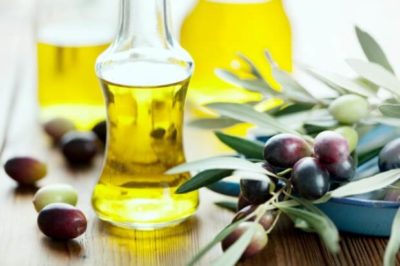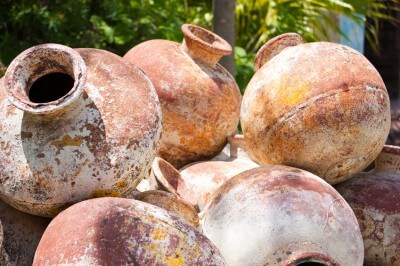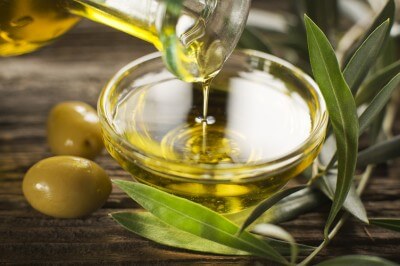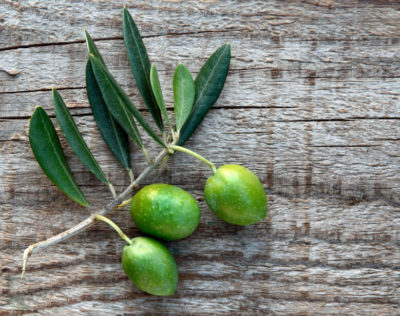Olive Oil: History, Types and Health Benefits

Close your eyes and think of the foods you’d eat on a Mediterranean holiday: Fresh seafood grilled to crispy perfection with lots of garlic and lemon. Vine leaves stuffed with herby rice. Salads bursting with juicy tomatoes, creamy bite-sized cubes of feta cheese and plump olives. Chunks of bread topped with a puree of eggplant and garlic. Sounds mouth-watering, right?
What these dishes have in common, aside from the fact that they all taste of sunshine and clear, blue ocean, is olive oil. In fact, the Mediterranean kitchen that doesn’t have a bottle of olive oil in it probably doesn’t exist.
In this article I’m going to take a really comprehensive look at olive oil:
The History Of Olive Oil
Types Of Olive Oil
The Health Benefits Of Olive Oil
How To Avoid A ‘Fake’ Olive Oil
Table Of Contents
The History Of Olive Oil
According to the Abrahamic religions, Noah sent out three doves at seven-day intervals after the Flood to see whether the water had receded yet. When the third dove didn’t return, he knew that there was dry land and they wouldn’t have to stay on the Ark for much longer. It’s significant however that the second dove came back with a branch, indicating that there were some treetops poking out above the surface of the water and that the water level was definitely dropping. The branch that the bird brought back to the Ark was from an olive tree.
The ancient Greeks told the story of a rivalry between the deities Athena and Poseidon. There was a beautiful city that they both wanted to be named after them. Zeus told them to each give the city a gift and then the local king would decide who would be the city’s patron and give it its name. Poseidon used his trident to strike a rock and a fountain appeared, which would have been a wonderful gift to a city that faced sporadic droughts. Unfortunately the god of the sea didn’t pay attention to the smaller details and the water that came from the fountain was salty, like seawater. Naturally the citizens of the city were underwhelmed with Poseidon’s gift to them. Then Athena came and planted a seed, which grew into an olive tree. The people loved this gift, because it would give them food, firewood, medicine from the leaves and oil. Athena won the competition and the city became known as Athens.
While it’s not clear when and where olive trees were first domesticated, these two stories show that they’ve been around for a long, long time. Neolithic peoples in the Mediterranean region collected wild olives as far back as 8000 BCE. The most likely candidates for the first domestication of olive trees are Asia Minor in around 6000 BCE, the Levantine in around 4000 BCE and the Mesopotamian region in around 3000 BCE.
The Canaanites, who lived in what is now Israel, were already making olive oil in around 4500 BCE. The oldest oil amphorae that archaeologists have found to date were used in around 3500 BCE by the early Minoan civilization, which lived in modern-day Crete. In fact, much of the Minoans’ wealth came from the export of olive oil. They would harvest the olives and mash them into a pulp. This pulp was then placed in a settling tank filled with water. When the oil had risen to the top, the water was drained from the bottom of the tank.

In Greek and Roman times, olive oil was stored in jars known as amphorae
The Greek poet Homer mentioned in his epic poems that Greece was the biggest producer of olive oil in 1500 BCE. The Greeks and the seafaring Phoenicians exported olive trees to their colonies in the western Mediterranean and the oil was used for trade. In around 1300 BCE, when the Israelites left Egypt for the land of Canaan, they would squeeze olives by hand to extract the oil. Later, oil presses were made. Archaeologists discovered an oil-production centre with more than 100 oil presses dating from around 700 BCE at the Philistines’ city of Ekron, today known as Tel Miqne, which lies about 35 km to the west of Jerusalem.
Back in the day, olive oil was highly valued. Homer actually called it ‘liquid gold’. Only olive oil could be used in the Menorah in the Jewish Temple in Jerusalem. The Hebrews didn’t crown their kings but instead anointed them with a specially mixed oil that consisted of myrrh, cinnamon, cassia and a mysterious substance called kaneh bosem, all in a base of olive oil. The prizes at the Panathenaic Games in ancient Greece were large, decorated ceramic vases known as Panathenaic amphorae, which contained around 40 liters of olive oil. If you won the chariot race, you received 140 of these amphorae, which would make you very wealthy indeed.
The Spartans would rub olive oil into their bodies as a moisturizer and to emphasize the physique while Greek athletes would receive olive-oil massages. Early Roman emperors would give olive oil as gifts during celebrations. It was the Romans too who developed the screw press to extract the oil, a technology that is still used today in some parts.
When the Spanish and Portuguese explorers sailed to the New World in the 16th century CE, they brought back foods like tomatoes, potatoes, maize and cocoa. However, they also introduced some marvels of their own to the New World, such as horses and olive trees. In the mid 17th century, the Dutch East India Company established a halfway station for its ships at the Cape of Good Hope and this is where the first olives in Southern Africa were planted, in 1661. Olive trees reached Australia in around 1805. Today, major producers of olive oil outside of the Mediterranean region include Chile, Argentina, the Southwestern USA, South Africa, Australia and New Zealand.
Types Of Olive Oil

Extra virgin olive oil is the purest, most sought-after kind, whereas lampante oil is not fit for human consumption
If you’ve ever found yourself standing at the shelves stacked with different olive oils in your local deli, you’ll probably have seen labels like ‘extra-virgin olive oil’ and ‘pure olive oil’. These aren’t the same thing. The International Olive Council classifies olive oil into different types, using criteria such as how they were produced. The basic types are as follows:
Extra-virgin olive oil
This is the Ferrari of olive oils, the one you want to drizzle over your salad. It’s produced only through mechanical processes, by pressing the oil from the olive pulp or by using centrifugation to separate the droplets from the pulp. It has a maximum of 0.8% free acidity, which refers to the amount of free oleic acid in the oil. The taste is superior, just like a fine wine tastes much better than your average table wine.
Extra virgin olive oil is on the of highest quality fats that you can include in your diet, and it’s the one that we recommend for your Candida diet plan. This page has much more information on how to complete your anti-Candida diet.
Virgin olive oil
Like extra-virgin olive oil, virgin olive oil is the product of nothing more than mechanical means of extraction. However it is often rancid and made from poor quality fruit, so it does not usually taste great. It has a higher free acidity, which can be as much as 2%.
Ordinary virgin olive oil
This one is similar to virgin olive oil but can have a free acidity of up to 3.3%.
Refined olive oil
Unlike the virgin oils, refined olive oil involves chemical treatment too. The acid content and strong tastes of virgin are neutralized by using filters such as chemicals or even charcoal. Its free acidity is no more than 0.3%. Oils labeled ‘pure olive oil’ or simply ‘olive oil’ are normally refined olive oil and sometimes they contain a little bit of virgin oil just for the added taste.
Olive pomace oil
This type of oil has a high smoke point, so it’s perfect for cooking. It’s similar to refined olive oil and is normally blended with virgin oil too. However, it’s extracted from the pomace, which is the solid substance that remains after the virgin oil has been extracted from the olive pulp.
Lampante oil
In the USA, this is known as ‘virgin olive oil not fit for human consumption without further processing’, which pretty much describes what it is. It’s a poor-quality oil produced through mechanical means and is used for industrial purposes. The word ‘lampante’ means lamp in Italian and lampante oil is suitable as a lamp oil too. It can be made edible by treating it and turning it into refined olive oil.
You may also see words such as ‘cold pressed’ and ‘cold extraction’ on the label. These don’t necessarily indicate that the oil wasn’t heated during the pressing process. In fact, the olives are normally harvested in October of November, when in some regions the temperatures outside can be quite low and when the olive pulp is too cold, it makes extraction of the oil very difficult. So, the pulp is heated up a little. In other regions the pulp is quite warm already simply because it’s so hot outside. Either way, the temperature of the pulp shouldn’t be more than around 25 °C. The olive pulp is pressed several times to extract as much of the oil as possible. When the label on the bottle says ‘first cold pressed’, what you’re getting is the oil from that very first press.
The Health Benefits Of Olive Oil

Both olive oil and olive leaf extract have been found to have medicinal properties
The ancient Greek physician Hippocrates had the radical idea that diseases weren’t caused by the gods but instead were the result of factors such as diet, the environment and living conditions. He found a huge variety of uses for olive oil in treating ailments and called the substance the ‘great therapeutic’.
Extra-virgin olive oil is one of the healthiest fats we know of, which is why we included it in our Candida foods list. It contains the vitamins E and K as well as omega-6 and omega-3 fatty acids, and it consists mostly of monounsaturated fats. Studies have shown that consuming olive oil, especially the extra-virgin kind, can help with conditions such as the following:
- High cholesterol
High cholesterol is one of the leading causes of cardiovascular disease. There are two types of cholesterol: LDL and HDL. LDL is considered the bad type of cholesterol and olive oil can help reduce levels of this in your blood. However, HDL is a good cholesterol and you need higher levels of this to be healthy. The great thing about olive oil is that it doesn’t reduce your HDL levels, In fact, it can increase them. - High blood pressure
Olive oil helps to reduce blood pressure, which in turn reduces your risk of heart disease and strokes. - Diabetes
Because olive oil helps to regulate blood-sugar levels, enhances insulin sensitivity and helps to reduce levels of low-density lipoproteins, it may help to prevent the onset of type-2 diabetes. It can also help diabetics to control the condition, provided of course that it forms part of a healthy diet. - Osteoporosis
Olive oil helps with the absorption of calcium, so it encourages the formation of strong, healthy bones. This means that it can help to prevent or relieve osteoporosis, but it’s also good to include olive oil in the diet of growing children so that they can develop healthy bones from the start. - Digestive ailments
Olive oil is gentle on your stomach and can act as a laxative, which is great when you suffer from constipation. It also helps for indigestion, acid reflux, ulcers, gastritis and pancreatic function. Because it encourages bile drainage, it can help prevent gallbladder disease too. And it is also an antifungal food that can help to correct gut dysbiosis like Candida. - Cancer
Loaded with antioxidants, olive oil helps to fight free radicals that can cause cancer. - Inflammation
Olive oil contains oleocanthal, a substance which acts as nature’s very own ibuprofen to reduce inflammation.
When you include olive oil in your diet, remember that like with anything else, too much of a good thing is not so good anymore. Olive oil is high in calories so, when you increase your intake, you need to think about what else you eat too or you may end up putting on more weight than you planned to. Medical professionals normally recommend an intake of about one or two tablespoons of olive oil per day.
Of course it’s not only on your inside that you want to be healthy. Olive oil is great for taking care of your outside too. Remember how the ancient Spartans used it as a moisturizer? It is often an ingredient in cosmetics and soaps that are gentle on your skin. You can use the oil to treat dry winter skin, cracked heels and lips, nappy rash and eczema. It makes a great hot-oil treatment or serum for shiny hair and because it’s such a great lubricant, it’s a wonderful substitute for shaving cream. Add some aromatherapy oils and you have the perfect massage oil too!
How To Avoid A ‘Fake’ Olive Oil

Higher quality olive oils will usually come in darker bottles, to prevent sunlight from turning the oil rancid
While Homer’s ‘liquid gold’ isn’t quite as valuable as the precious metal, there’s still good money to be made from the production and sale of olive oil. Unfortunately, just as in any industry where people can make money, there are unscrupulous producers and distributors who aren’t entirely honest about what they’re selling.
In recent years, numerous studies worldwide have shown that a disconcertingly large percentage of extra-virgin olive oils on the market aren’t what they claim to be. Most often, the higher-quality extra-virgin oils are mixed with inferior or refined olive oils. Sometimes coloring and other substances are added to fake the color or taste of the real thing. Some producers also mix the olive oil with other oils, such as soybean or peanut oils.
Considering how much you pay for a bottle of extra-virgin olive oil, it can be really upsetting to find out that it’s fake. However, it’s not only the money you’ve parted with that’s the issue here. While soybean and peanut oils both have health benefits, they’re not olive oil. Besides, what if you’re allergic to soy or peanuts?
As a consumer, you can never be entirely sure that the olive oil you’re buying is indeed made of olives and nothing else. However, there are ways to increase your chances of buying the real thing. Some people believe that you can just put the bottle in the fridge to check the purity of your olive oil. They say that olive oil will become cloudy and thick as it cools because of the high monounsaturated fat content. Soybean oil, for one, doesn’t normally do that because it’s high in polyunsaturated fats instead.
The problem with the so-called ‘fridge test’ is that it’s not reliable. In fact, you just need to look at how easily coconut oil, which is high in saturated fats, becomes solid even at cool room temperatures to realize that the fridge test is flawed. Sometimes extra-virgin olive oil remains liquid, for instance, or other oils high in monounsaturated fats, such as some types of canola oil, will become more solid too. Researchers at the University of California, Davis’ Olive Center did a much-publicized experiment in which they placed seven different oil samples, including extra-virgin olive oil, in the fridge. Not one of the samples solidified but the one that became the thickest of the lot was a blend of olive and canola oils.
Better ways to increase your chances of buying real olive oil include the following:
- Forget about the color
It’s easy to fake olive oil by simply adding green coloring to other oils. Besides, pure olive oil doesn’t always have the same color. It can come in many different colors, depending on the harvest and other conditions. In fact, people who test olive oils often wear colored glasses so that they won’t be fooled by the color of the oil. - Rely upon your sense of smell and taste
Olive oil has a distinctive smell and taste. It has a complex mix of aromas that depend on where the oil was produced but it should smell fresh and ‘green’, almost like freshly cut grass. There should be a definite taste of olives with other layers, such as a bit of a peppery taste or even a slightly bitter taste. It should not taste greasy, rancid, and moldy or like cardboard. If you can, attend some olive oil tastings to learn what to look for. - Check the bottle
Real olive oil can go rancid very easily if it’s exposed to too much light. To prevent this, reputable producers normally use bottles that are darker in color. - Check the label
Of course, just because it says on the label that it’s extra-virgin olive oil doesn’t mean that it actually is extra-virgin olive oil. However, there are some other clues on the label that will give you an idea of the quality of what you’re buying. Smaller producers often add details such as the name of the farm where the olives were grown, the date when the olives were harvested and the variety of olives used. While smaller doesn’t necessarily mean more honest, these producers are generally not quite as profit-driven as industrial-scale producers and have less reason to cheat. - Check for certification
Good olive oils go through a stringent quality-control and certification process. In Italy, they’ll receive PDO or PGI seal of approval. PDO means ‘protected designation of origin’ while PGI means ‘protected geographical indication’. Other reliable seals of approval are those of the Australian Olive Association and the California Olive Oil Council. - Check for awards
Buying an award-winning olive oil not only guarantees that you’ll get a quality oil but it’s also a good way to increase your chances of buying the real thing. After all, fake olive oils don’t win awards. - Buy directly from the mill
Naturally you don’t have any guarantee that the olive oil isn’t adulterated right there at the mill, but buying directly from the producer eliminates other steps in the process where cheating may occur. In fact, much of the fraud in labeling olive oils happens during the import process. Another advantage of buying straight from the mill is that you can ask to taste the oil before you buy. - Don’t buy the cheapest brand available
Just like everything else in life, there is a reason why some olive oils are much cheaper than others. While you can’t be sure that the most expensive oil will be the best quality, you can be sure that the cheapest brand won’t be the best. Olive oil really is just like wine: that cheap bottle of red wine is not usually a good idea!

